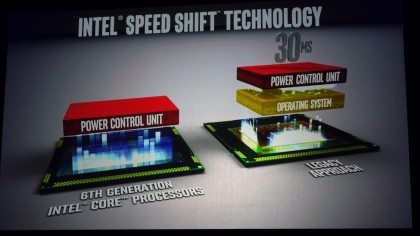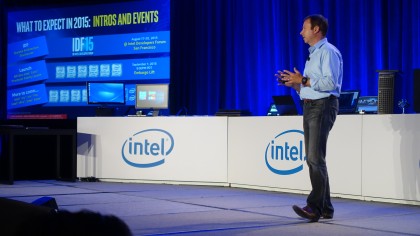Intel Skylake performance boost will tempt you to upgrade your laptops
It's time for an upgrade
Windows support
Skaugen said Intel worked closely with Microsoft to support some of the biggest Windows 10 features on Skylake. Skylake now comes with an audio processor to support dual-array microphones to improve speech recognition when using Cortana, and a dedicated image signal processor helps with RealSense 3D support on Windows Hello.
Intel is positioning its next-generation RealSense cameras not only as a biometric security tool for Windows logins, but for 3D scanning, immersive computing and new user experiences.
The ISP can also be used for even more powerful cameras and graphics work, supporting more cameras, higher resolution sensors and faster video encoding as well. Intel revealed some of these details ahead of IFA at IDF 2015, and you can read our coverage for additional details.
For videos, Skylake supports HEVC and most of the popular video codecs, along with DirectX 12, OpenCL 2.0, OpenGL 4.4 and Vulkan for graphics. It also supports lossless color compression.
The platform supports faster wake from sleep for laptops, support for Thunderbolt and USB-C. There is also support for wireless display (WiDi), wireless docking (WiGig), conference room solutions (Intel Unite) on Skylake, with planned support for wireless charging with Rezence coming towards the end of 2016.
Shifting into faster gear
For users who need even more performance on mobile, Skylake will offer a quad-core architecture on the Core i5 line for the first time for notebooks. Previously, if you want a quad-core laptop, you'll have to upgrade to an Intel Core i7 series processor.
Additionally, gamers will be happy to know that Intel will also bring an overclocking K SKU to laptops. Overclocking can be tuned individually by the user, turned on with software controls or activated with a dedicated hardware overdrive button, Shenoy said.
Are you a pro? Subscribe to our newsletter
Sign up to the TechRadar Pro newsletter to get all the top news, opinion, features and guidance your business needs to succeed!
Mobile workstations users will also benefit in a new addition to the Skylake family. For the first time ever, Intel is making its Xeon architecture on laptops, and Lenovo recently announced its new ThinkPad P Series.

There is also a new technology that will make your computing even more responsive. Intel introduced Speed Shift Technology along with Skylake, which helps the processor and the OS work more cooperatively to handle power management and increase processor frequencies for the right task.
Prior to speed shift, power management was divided between the OS and the processor. But this takes about 30 milliseconds for the processor to tell the OS that a task has happened for the operating system to adjust the frequency. Speed Shift cuts this time to 1ms, making graphics and processing task appear even more responsive to the user. For most common tasks, Skylake will pick the efficient frequency to operate without any OS intervention, and it can go down to just 100MHz.
Businesses will have to wait
Business users looking to upgrade to Skylake may have to wait until 2016 to get the most out of the platform. Enterprise features such as Intel vPro, mobile Xeon, and Iris and Iris Pro integrated graphics won't arrive until late 2015 and into 2016, Shenoy revealed.

Skylake will ship with security features, like Intel Software Guard Extensions and Intel Memory Protection Extensions.
"Intel Software Guard Extensions (Intel SGX) is an Intel Architecture extension designed to increase the security of software through an "inverse sandbox" mechanism," Intel said in a statement. "In this approach, rather than attempting to identify and isolate all the malware on the platform, legitimate software can be sealed inside an enclave and protected from attack by the malware, irrespective of the privilege level of the latter."
It also supports TrueKey for hardened multi-factor authentication.
Are you ready to upgrade your notebook?
Intel claims that we'll see 300 new mobile designs and 200 new desktop designs with Skylake, leading to a total of 500 new systems. Mobile designs include laptops, Ultrabooks, mobile workstations and tablets, while desktop designs include towers, NUCs, mini PCs and all-in-ones.
Read our review of Skylake